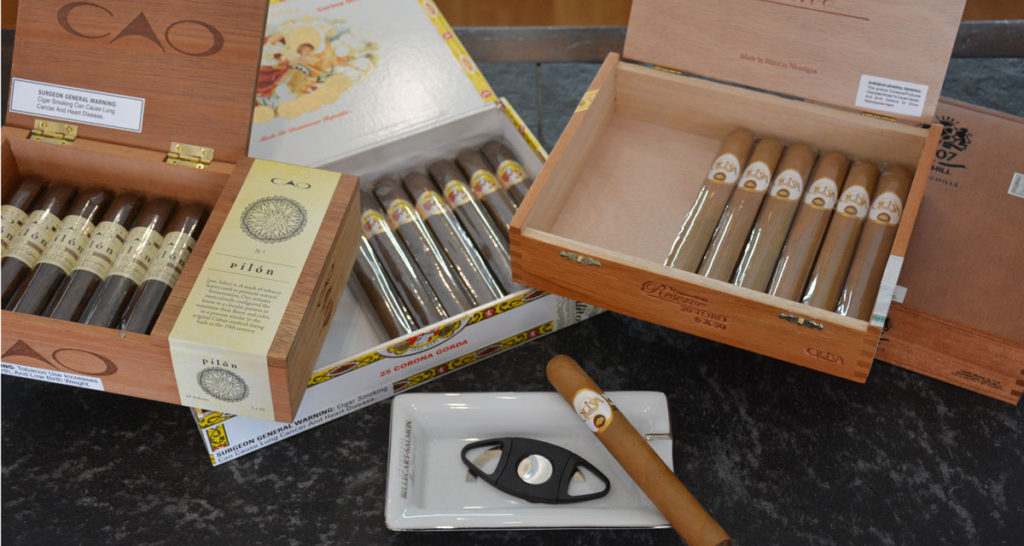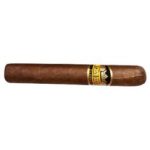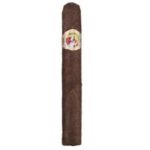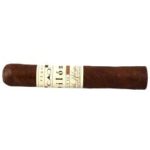
Cigars by the Sea
October 4, 2016What’s in Your Humidor?
Select, smoke, enjoy, repeat. Sounds pretty simple when it comes to the world of cigars. However, the analogies of handcrafting an outstanding stogie and a delicious wine are more similar than one would think. This makes it difficult for the person who wants to have the occasional smoke on a special occasion to make the right selection. Sharing in your victory at the Member-Guest golf tournament at one of Nantucket’s private clubs requires a different smoke than bringing home the largest catch for the Big Game Battle fishing tournament, not to mention a special gift for the friends you asked to wear tuxedos at your wedding!
Cigars are named and classified according to their size and shape, along with their most distinctive feature being the outside wrapper. The shape of a cigar is measured according to its length, typically measured in inches, and diameter, measured according to its ring gauge. Ring gauge is a unit of measurement divisible by 64, where most cigars have a ring gauge of 64 or less. While the ring gauge system may appear confusing at first, the trick is to know that it measures the diameter of a cigar in units of 64 where 64 is equal to 1 inch. Therefore, a ring gauge of 48 would be a ¾ of an inch thick (48/64).
The most common shape of a cigar is called parejo. This translates to ‘parallel’ in Spanish and refers to a cigar with a straight barrel and a rounded head this it typically clipped before smoking. Examples of this can be found in numerous popular styles of cigars. One such is known as Churchill, measuring 7 inches X 48 ring gauge, which is in reference to the size of cigar that was favored by the British Prime Minister Winston Churchill. (Yes, the same person for whom Champagne Pol Roger named their tête de cuvee!). The most common size and in which many variations are made (see below) is Corona, at 5.5 inches long X 42 (or a slight variation of 6 X 44). While vary popular today due but only made in the past few decades, Robusto, coming in at 4.5 inches X 50 (and again an alternative size at 5.5 X 50) is popular for offering more girth without the length – hence the name.
Cigar Suggestions:
 CHURCHILL: Dunhill Churchill 1907, 7 X 49 (Dominican Republic)
CHURCHILL: Dunhill Churchill 1907, 7 X 49 (Dominican Republic)
Perfect mild cigar to pair with a Blanc de Blancs Champagne
 CORONA: La Gloria Cubana Corona Gorda, 6 X 52 (Dominican Republic)
CORONA: La Gloria Cubana Corona Gorda, 6 X 52 (Dominican Republic)
This will make your groomsmen proud!
 ROBUSTO: CAO Pilón Robusto, 5 X 52 (Nicaragua)
ROBUSTO: CAO Pilón Robusto, 5 X 52 (Nicaragua)
To share with your golf team that did (or didn’t) win the tournament.
The growing of tobacco leaves and its fillers can take around 18 weeks, yet sometimes much longer for certain wrappers. While Cuba has historically been known to produce quality cigars (and are the hardest to get), cigar making in the Domincan Republic, Honduras, Nicaragua and even in the US of A (especially CT) has significantly improved as of late. Lower end cigars will use short fillers, which consist of bits and pieces crammed together to make a specific shape. Higher end selections will use long fillers where the tobacco leaves run the length of the cigar, making it a much better smoke. Like a winemaker will blend different grape varietals together to come up with a sum greater than its parts, the same is true in cigar manufacturing. A cigar maker will blend different filler leaves together to create unique tastes and flavors, encouraging you to choose a handmade cigar over mass-produced ones made by machine.
Whether a cigar is made of short or long-filler tobaccos, the filler leaves are always secured within a leaf called the binder, which sits just beneath the wrapper. The tobacco is put into a wooden mold and pressed into shape for about an hour. All premium cigars made in this manner, both with short or long-filler, are labeled “hecho a mano,” which means made by hand. Finally, the roller then wraps the bunch in a wrapper leaf, which is supple, very elastic and visibly pleasing. This is what you see on the outside of the cigar and the most important element.
The wrapper is what gives the cigar its appearance and smell, along with providing much of the taste. The color and sheen of the exterior wrapper are the initial attributes a smoker notices when looking at a cigar. You have surely seen a cigar connoisseur run a cigar under the tip of their nose, inhale deeply and assess the quality of the tobacco. The ideal wrapper must have very few blemishes and be made from rather large leaves in order to properly wrap the cigar. While all leaves originally start out as green in color, the aging process is what creates different shades of brown.
Wrappers range from light tan to dark chocolate brown with many variations in between. Claro wrappers are typically from the Northeastern United States, specifically Connecticut. They are a very light tan color, being almost beige in their hue. Sometimes referred to as Natural or CT (as an abbreviation to the state in which in they hail), the soft color is a result of the leaves being grown under some sort of protection, namely cheesecloth, to help keep the color light. The shade and lack of sunlight to cause the leaves to mature also makes them much milder in flavor. Tastings notes include cream, butter, black or white pepper, coffee, cedar and an overall drier taste.
Colorado is a definite shade darker than the CT and distinctive by its reddish-brown hue. Wrapper is fairly durable and strong in flavor as it hasn’t been aged enough to make it too soft, leathery and not as dry or fragile as one that has been aged for a shorter duration. These tend to be very aromatic, almost robust with hints of spice including cardamom and cinnamon, and rich in flavor.
A very dark brown, almost black, wrapper is Maduro translating to mature or ripe which is exactly what these wrappers are. Once picked, the leaves go through a long curing and drying process to properly darken and flavor the leaf properly. This aging brings out the natural sugars in the tobacco leaves, creating a sweeter smoke than a leaf wrapper that has not been aged as long. Think dark chocolate, coffee, brown sugar, caramel, molasses, dried fruit. Because of such sweetness, these types of cigars are often reserved for smoking as a nightcap or a dessert smoke.
Cigar Suggestions:
 CLARO: Oliva CT Reserve, 6 X 60 (Nicaragua)
CLARO: Oliva CT Reserve, 6 X 60 (Nicaragua)
Match with your favorite California Chardonnay (Kistler, anyone?).
 MADURO: Don Tomas Clasico Maduro Robusto, 5 ½ X 50 (Honduras)
MADURO: Don Tomas Clasico Maduro Robusto, 5 ½ X 50 (Honduras)
Late night smoke to pair with a Late Bottled Vintage Port.
Once you are able to master a few key components about the anatomy of a cigar, then you are well on your way to being able to choose one to your liking. Of course, practice makes perfect so don’t be afraid to experiment with a couple different selections to fine-tune your favorite type.
Comments